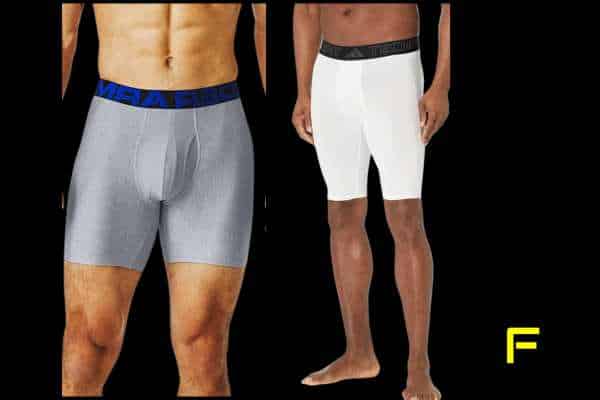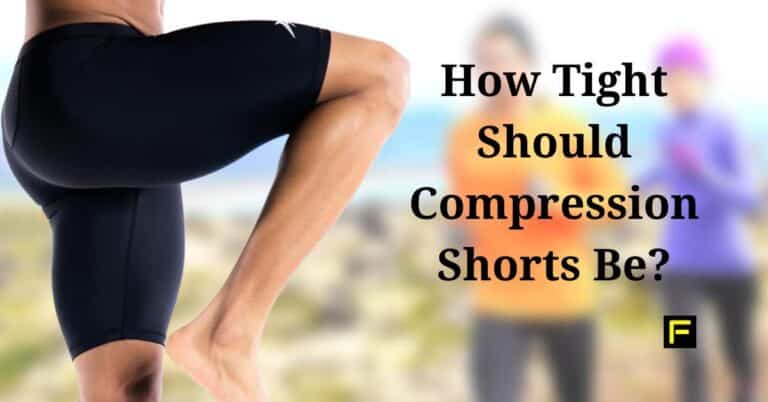How Tight Should Compression Shorts Be? Compression shorts are popular with many athletes and fitness enthusiasts for their ability to provide support and improve performance. The effectiveness of these shorts is largely dependent on their fit.
** I may earn a commission when you purchase through a link on this page. **
When trying on a pair, the fit should be snug but not so tight that it restricts circulation or hampers movement. Your shorts must deliver even pressure across the muscles they cover without causing discomfort or shifting during activities.
Knowing how to measure yourself is essential for achieving the optimal fit. It’s not just about waist size; thigh circumference and personal comfort level also play significant roles.

Every brand might fit slightly differently, so it’s a good idea to check the sizing chart of the brand you’re interested in. Some trial and error may be needed to find your perfect pair, but taking the time to adjust for your body type and activity level will pay dividends in comfort and performance.
Practicing good care and maintenance extends the life of your compression shorts, ensuring they continue to provide the benefits of improved circulation, reduced muscle soreness, and better recovery.
Key Takeaways
- Compression shorts should fit snugly but allow free movement.
- Correct measurement and trying different brands can help find the best fit.
- Proper care ensures the sustained performance of your compression shorts.
Determining the Right Fit for Compression Shorts
When selecting compression shorts, finding the right fit is crucial for both comfort and functionality. Remember, they should fit snugly, almost like a second skin, but not so tight that they restrict movement or circulation.
Here are key tips to help you ensure a proper fit:
- Measure Yourself: Start by taking your measurements. Use a measuring tape to find the circumference of your waist and hips.
- Check Size Charts: Compare your measurements with the provided size charts from the manufacturer, as sizes can vary between brands.
Fit Guide:
- Waistband: It should sit flat and comfortably without digging into your skin.
- Length: Depending on the style, the shorts should either cover your thighs completely or stop just above the knee, without riding up.
- Compression Zone Fit: The material should apply even pressure throughout your muscles without any bulging or pinching.
- Mobility: Perform a few squats or stretches. Properly fitted shorts will allow full range of motion without restrictions.
Remember, the sensation of compression is expected, but you should never feel discomfort or pain.
For instance, compression wear should be form-fitting but still comfortable. If you’re in between sizes, consider how you’ll be using the shorts.
For high-intensity activities, lean toward the smaller size for increased muscle support. For all-day wear or recovery, the larger size may offer sufficient compression with greater comfort.
It’s worth checking out Testimonials or Reviews for personal accounts on the fit and feel of specific brands. With the right fit, your compression shorts will support your performance without any distractions.
Benefits of Properly Fitted Compression Shorts
When your shorts fit just right, they can offer you a blend of support and comfort, enhance your circulation, and help prevent injuries during physical activities.
Support and Comfort
Properly sized shorts will hug your body snugly without being too constrictive. This ensures that your muscles are supported during exercise, which can reduce muscle fatigue and soreness.
Well-fitting compression shorts can prevent uncomfortable bunching or sliding, keeping you focused on your workout.
Improved Circulation
A key benefit of compression shorts is their ability to improve blood flow. By applying even pressure on your muscles, they can help circulate blood more efficiently, delivering oxygen to your muscles and helping to remove metabolic wastes like lactic acid. This can be particularly beneficial after exercise to aid in recovery.
Injury Prevention
Performance shorts are designed to provide stability to your muscular structure. By wearing shorts that fit correctly, you can minimize muscle oscillation and maintain proper alignment, which lessens your risk of pulls and strains.
Research suggests that this support is especially valuable for protecting against injuries in the hip adductor muscles.
Factors Influencing the Fit
Choosing the right shorts is crucial for performance and comfort. Here are key aspects to consider to ensure you get the perfect fit.
Material and Fabric
The material used directly affects their elasticity and fit. Look for a blend of spandex or lycra for stretchability, and nylon or polyester for durability. A higher content of spandex or lycra usually offers a snugger fit.
Compression Level
Compression level is measured in mmHg and dictates the tightness of the shorts. A higher number means more pressure, which should be snug but not restricting. Ensure it supports without causing discomfort or impairing circulation.
Brand Sizing Guidelines
Each brand has its sizing guidelines. Carefully review the brand’s size chart, as sizes can vary significantly between brands. Pay attention to waist and hip measurements to match the brand’s recommendations for an ideal fit.
How to Measure for Compression Shorts
When selecting compression shorts, getting the right fit is crucial for comfort and performance. Here’s how to measure yourself to find the perfect pair:
Find Your Waist Measurement:
- Wrap a tape measure around your body at your natural waistline, which is the narrowest part of your torso, located just below your rib cage and above your belly button.
- Ensure the tape measure is parallel to the ground and snug but not tight.
- Record the measurement in inches or centimeters.
Measure Your Hips:
- Locate the widest part of your hips.
- Wrap the tape measure around your hips, ensuring it remains horizontal.
- Again, the tape should be snug but not constricting.
Consult the Size Chart:
- Use a size guide for compression clothing provided by the brand you’re interested in.
- Brands may vary in their sizing, so it’s important to use the specific chart for the shorts you want to purchase.
Remember that compression shorts should fit snugly, but not so tight that they restrict circulation. A well-fitting pair will feel like a second skin, without causing discomfort. If in doubt, consider the nature of your activity and personal comfort preferences. Some athletes prefer a tighter fit for added support, while others opt for a little more give.
Adjusting for Different Body Types
Finding the right fit depends largely on your body type. They should feel like a second skin, providing support without constricting movement.
For Slim Builds
If you have a slim build, look for a snug fit, ensuring that the material doesn’t sag or bunch. The waistband should be tight enough to stay in place, but not so tight it digs in. Make sure they are form-fitting yet flexible to avoid uncomfortable shifting during activities.
For Muscular Builds
Muscular builds require shorts that can accommodate larger thighs without being too loose around the waist. Opt for styles with a graduated compression—tighter at the bottom and more relaxed towards the waistband—that will support your muscles while enabling a full range of motion.
For Broader Builds
For those with broader builds, it’s important to look for compression shorts with a wide waistband that won’t roll down during movement. The fit should be firm around the legs and seat to provide adequate compression while offering enough stretch to ensure comfort around your midsection.
Troubleshooting Common Fit Issues
It’s normal to experience a few fit issues at first while wearing these tight-fitting shorts for the first time. Identifying and resolving these can ensure the comfort and effectiveness of your compression gear.
Waistband Rolling
If you find the waistband of your compression shorts rolling down, it’s often a sign they’re too tight or too loose around your waist. To fix this, ensure the waistband sits flat and snug on your waistline without leaving marks. Sometimes, selecting a pair with a wider waistband or adjusting the position slightly can also prevent rolling.
Thigh Band Squeezing
They should be firm but not constrictive around the thighs. If the thigh bands are squeezing too much, they might be too small.
Look for compression shorts with graduated compression, which provide firmer support at the bottom and less towards the top, to prevent squeezing and ensure a proper fit.
Restricted Movement
Your movement should never feel restricted by your shorts. If it does, the size may be too small, or the compression level too high for your needs.
The right pair will allow you to move freely while still feeling the support. Checking the stretch and fabric elasticity can guide you to a pair that enhances mobility.
Use this information to ensure you’re getting the most out of your compression shorts without compromising on comfort.
Care and Maintenance of Compression Shorts
Proper care of your compression shorts extends their life and ensures they maintain their fit. Here’s a straightforward guide to keeping your shorts in prime condition:
- Wash Frequently: You should wash your shorts after each use. Sweat and oils can break down the material over time.
- Cold Water is Key: Use cold water for washing your shorts, as high temperatures can degrade the elastic fibers.
Washing Instructions Details Temperature Cold Cycle Type Gentle or hand wash Detergent Mild, without harsh chemicals Avoid Heat: After washing, do not wring them out. This can stretch the fabric. Lay your shorts flat to dry and avoid using a dryer, which can also damage the elasticity.
- Air Dry: Lay flat and allow to air dry completely before the next use.
- Storage Matters: Store your compression shorts in a cool, dry place. Folding them neatly can prevent unnecessary stretching or wrinkles that may affect the fit.
Using these methods, your compression shorts should remain snug and effective for your athletic pursuits. Remember, while some bunching can happen, the waistband should stay securely in place without much need for readjustment.
When to Replace Your Compression Shorts
Knowing when to replace your compression shorts is key to maintaining the benefits they provide. Here’s a simple guide to help you determine if it’s time for a new pair:
- Elasticity Loss: If your shorts aren’t snapping back into shape after a wash, they’ve likely lost their compression qualities. Good compression wear should feel snug but not restrictive.
- Fabric Wear: Check your shorts for thinning material, particularly in high-friction areas. If they’re becoming transparent or the fabric is pilling, it’s time for an upgrade.
- Comfort Reduction: When the once comfortable waistband starts digging in or you notice chafing, consider this a sign that the fitting is no longer optimal.
- Performance Decline: If you initially felt a performance or recovery boost that now seems absent, your compression shorts may no longer be providing adequate support.
| Signs to Look Out For | Reason to Replace |
|---|---|
| Looser fit than before | Loss of compression effect |
| Noticeable sheerness | Fabric degradation |
| Persistent discomfort | Elastic and fit deterioration |
| Diminished performance aid | Reduced support and benefits |
Remember, while high-quality compression shorts are built to last, they won’t last forever. Regular assessment and timely replacement will ensure you continue to enjoy benefits like improved muscle recovery and comfort during your activities.
Keep an eye on these indicators, and don’t hesitate to invest in a new pair when you see the signs. Your body and your workouts will thank you.
Frequently Asked Questions
Compression shorts should fit snugly without restricting movement, and there are specific characteristics for athletes, such as basketball players, that offer additional benefits during sports.
What is the optimal fit for compression shorts?
The optimal fit should feel tight but not restrictive, allowing for a full range of motion. The shorts should sit flush against your skin to provide the needed compression without causing discomfort.
What benefits do compression shorts provide for basketball players?
Compression shorts support basketball players and may help reduce muscle fatigue and soreness during and after play. The material often has moisture-wicking properties, which help keep players dry and comfortable on the court.
Is it better to choose a smaller or larger size when buying compression shorts?
When shopping for the right pair, it’s crucial to select a size that will provide ample compression without being overly tight. Choosing a smaller size for more compression is not recommended if it means sacrificing comfort or circulation.
How can you tell if compression tights are too tight?
Compression tights are too tight if they cause discomfort, restrict your movement, or leave marks on your skin after use. Properly fitting compression wear should offer support and improve circulation without any negative side effects.
Should undergarments be worn beneath compression shorts?
It is a personal preference whether to wear undergarments beneath compression shorts. Some shorts are designed to serve as underwear, while others can be worn over underwear or as a base layer.
Are there any differences in fit between men’s and women’s compression shorts?
Yes, there are differences in the fit of men’s and women’s compression shorts, mainly due to differing body shapes. Women’s compression shorts may offer more room in the hips and a different cut in the waist, tailored to female body types.

Rick Huey is a fitness writer who has dedicated his life to living an active lifestyle. With more than 30 years of experience in the fitness industry, Rick is a respected contributor for FitFab50.com, where he shares his wealth of knowledge with a wide audience. His dedication to promoting the benefits of living an active lifestyle has inspired many people to pursue their own fitness journeys with enthusiasm and dedication.

